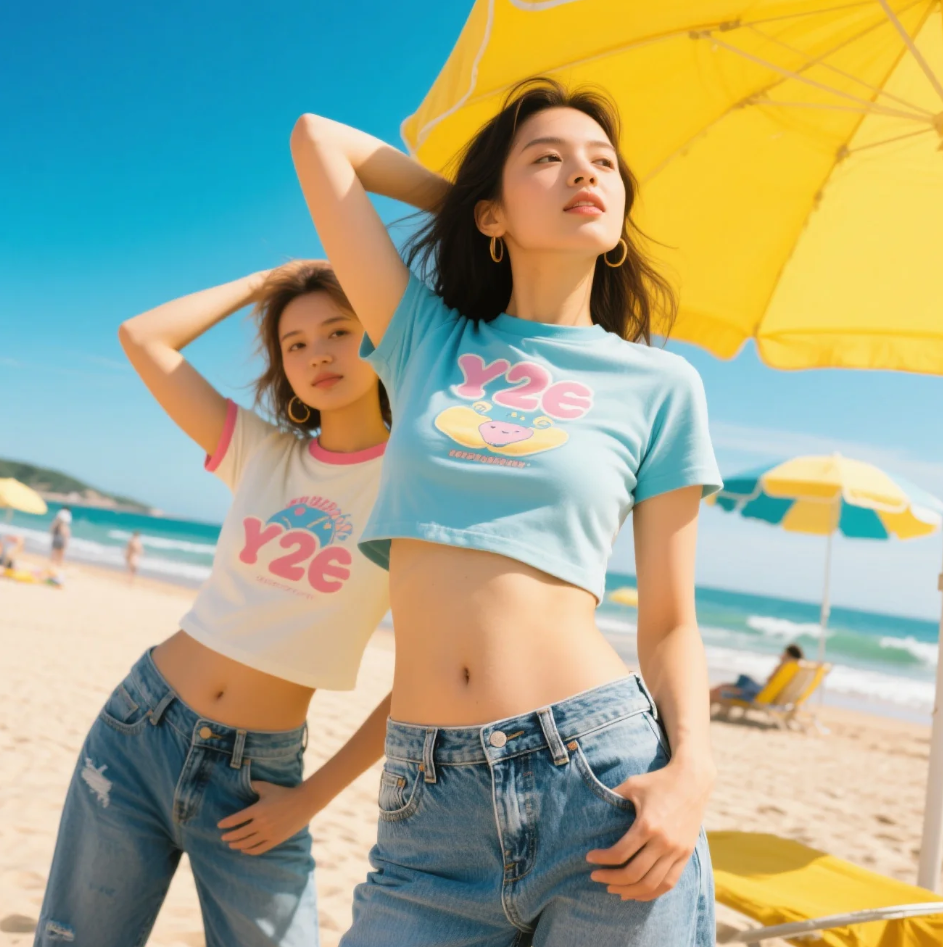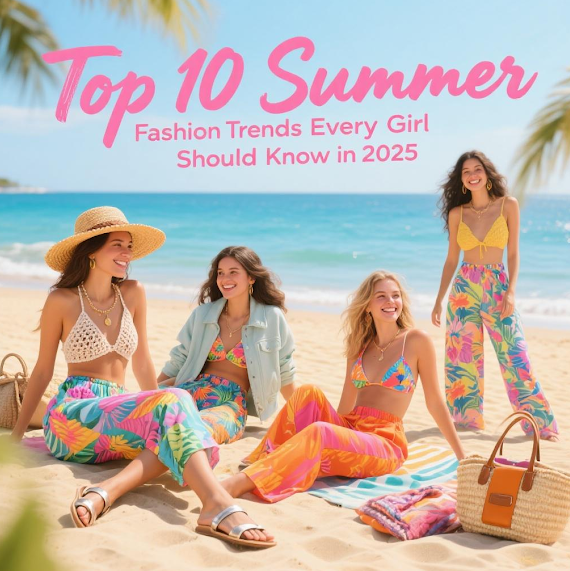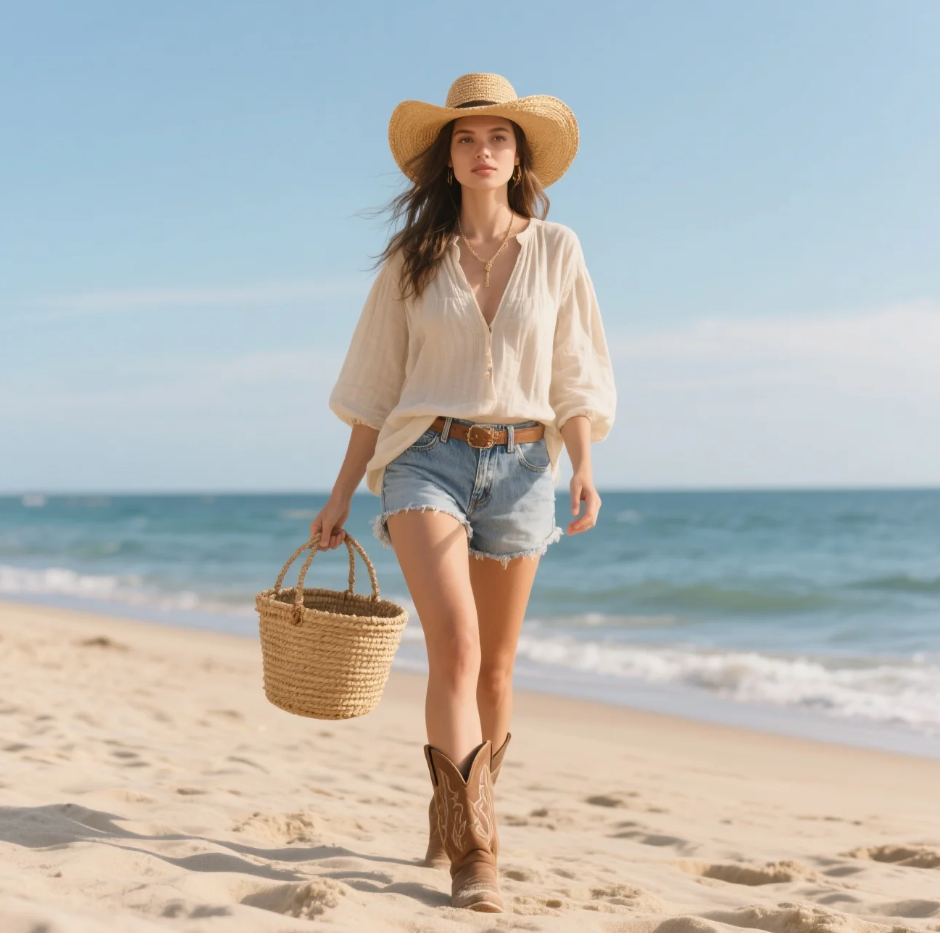The summer of 2025 feels like a time warp—sun-drenched streets, digital memories, and that unmistakable pull toward Y2K nostalgia. It’s the season of low rise jeans, baby tees, metallic finishes, butterfly clips, and all the unapologetic charm of early‑2000s style. Yet this revival is anything but a costume—it’s a thoughtful reinvention rooted in cultural cycles, sustainable fabrics, and modern confidence.
I still smile thinking about the first time my friend Sasha appeared at brunch in her new low‑rise flare jeans and graphic baby tee. I hardly recognized her—this version of herself was bold, young, and playful. She tapped her foot to the 2000s soundtrack I curated, layered on transparent sunnies, and winked: “I feel like me again.” The effect was contagious, sparking curiosity among our group and prompting that evening’s group text: “Send me the links please!” That’s when I realized Y2K fashion had become more than nostalgia—it was a collective return to joy.
Behind the trend lies cultural resonance. Experts explain that Y2K fashion reflects a yearning for optimism after global turbulence, when technology glistened with promise and style was fearless and experimental . The resurgence of low‑rise jeans—once synonymous with Britney and Paris—is now contextualized by deeper meaning. Gen Z and millennials aren’t just dressing for nostalgia, they’re embodying that era’s unfiltered self‑expression, merging it with sustainable fabrics and modern fits .
Low‑rise denim in 2025 often comes in higher-quality, eco-conscious cotton blends with recycled fibers and deadstock fabric. Brands highlight performance stretch, responsible sourcing, and a flattering mid-rise twist. I purchased a pair of light‑wash, organic low‑rise jeans last month. That night, I wore them to a backyard bonfire with my partner. As I leaned to toast marshmallows, the pocket embroidered with a tiny flower reminded me: these jeans share a story of intention, creativity, and climate awareness.
Baby tees—tiny, fun, and fearless—complete the look. Whether graphic slogans or rhinestone embellishments, these cropped tees catch the eye and evoke 2000s whimsy . I sent one to my niece, who wore it to her first concert. She danced under stage lights, texting me through the crowd: “I love this tee!” Her joy was immediate proof that the aesthetic thrives when you feel truly yourself.
The Y2K fashion ecosystem extends beyond denim and tees. Metallic finishes, holographic bags, butterfly clips, cargo pants, and platform sneakers all echo that era but are interpreted through a modern lens . My sister-in-law gifted me butterfly clips—and I fell for a moonlit rooftop party, pinning them into my loose braid. Every head turn sparked questions, and I found myself explaining not just styling tips, but the idea behind the trend: playfulness reimagined.
This revival is also fueled by viral platforms. TikTok and Instagram reels overflow with Y2K styling tips, remixing early aughts icons with today’s silhouettes . Vintage stores like Flight Girls in Connecticut report resurgence in pre-loved low‑rise pants, mini skirts, and baby tees, as nostalgia meets sustainable shopping . The result is joyful cycles of reuse, story-sharing, and eco-consciousness.
Celebrity influence adds fuel. Megan Thee Stallion rocked ultra low‑rise jeans and denim bikini top at Coachella 2025—flaunting the iconic “whale tail” silhouette with swagger, signaling mainstream readiness. Influencers pair micro-mini cargo skirts with platform sneakers and tinted sunglasses. Even runway stylists are blending Y2K with techwear, layering holographic accents and oversized visors for Cybercore credentials .
But the Y2K finish of 2025 feels current—not costume. Tailoring is sharper, fabrics are softer, and accessorizing is thoughtful. I wore low‑rise straight-leg jeans with a ribbed baby‑blue tee, a cropped white cardigan, and square-toe sandals to a friend’s gallery opening. Someone stopped me to ask about the look, and I found myself explaining balance: the low-rise denim grounded casual play, while the cardigan and sandals signaled polish. It felt natural and modern—a moment made richer by shared curiosity.
Retailers also embrace this approach. Popular keywords—low rise jeans, baby tee, Y2K aesthetic, Y2K fashion trends, metallic crop top—are everywhere for good reason. Shoppers find elevated basics, sustainable denim lines, and graphic tees with cheeky slogans. Some of the standout pieces I discovered: a holographic mini bag woven from recycled plastic, rhinestone-trimmed baby tee with UV-protective fabric, and low‑rise jeans spun from organic cotton dyed in pastel tones.
Beyond physical items, Y2K fashion intersects with identity. At a family barbecue, my cousin wore a cropped rhinestone tee over a white tank, paired with a low‑rise cargo skirt and platform sneakers. She flitted between cooking burgers and dancing with her nephew. I saw confidence and freedom in each move, and the kids attempted butterfly‑clip accents in their baseball caps. Style met play and memory blended with moment—what fashion should feel like.
We tend to think of fashion as expression through clothes, but then someone told me: it’s expression through light, energy, and confidence. That describes the Y2K revival—intentional, joyful, unfiltered, and evolving.
Even those who lived through the Y2K era feel its presence. My friend Claire, who swore off low-rise jeans years back, mentioned she’s rediscovered them—but this time with vintage Levi’s reintroduced in small batches, paired with high-quality organic cotton tees. She told me she feels nostalgic and entirely herself—making peace with what she loved then and reclaimed now.

There’s also subconscious resistance to minimalism. After years of neutral wardrobes and sleek silhouettes, people crave color, textures, fun. Y2K brings back vibrancy—pinks, silvers, icy blues, rhinestones—that pop against the neutral sea. Metallic crop tops reflect sunlight; butterfly prints lift moods. They invite play. They provoke smiles.
Yet the Y2K comeback isn’t without questions—practicality, body inclusivity, environmental resource use. This resurgence answers with inclusivity: mid-to low-rise options, sizes beyond standard, soft stretch fabrics, and thrift-minded styling. You don’t have to reveal everything—you choose your version of statement and comfort. A friend in plus-size found low-rise wide-leg jeans with a higher back waist and baby tee cropped in a longer line. She said she felt practiced discovery of personal style—nostalgia tuned to her reality.
There’s also a thoughtful subgenre—Indie Sleaze, cybercore—which leans on grunge textures, mesh layers, metallics, punk accessories . It’s an invitation to reinterpret document era energy as empowered postmodern self-expression. I experimented with mesh-layered baby tee over bandeau and metallic cargo pants to a DJ night. The vibe was bold—club meets Y2K—service of identity and energy, woven by trends but amplified by motion and confidence.
The revival isn’t short-lived. Fashion cycles return every 20 years—and the Y2K cycle reaches maturity now . But this time, it isn’t reactive—it’s regenerative. Vintage meets sustainable production. Nostalgia meets innovation. Bold meets inclusive.
So as we lean into summer 2025, the Y2K aesthetic offers more than retro play—it presents stylized confidence, restored self‑expression, and community. It says: Let’s wear joy. Let’s craft identity with fun. Let’s blend what we loved with who we’ve become.
That evening when Sasha wrapped me in a hug at brunch, the jeans slipped and our laughter echoed: “This feels like you, but even better.” And that’s why Y2K summer fashion is back—and not just for show.



